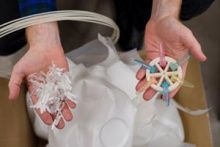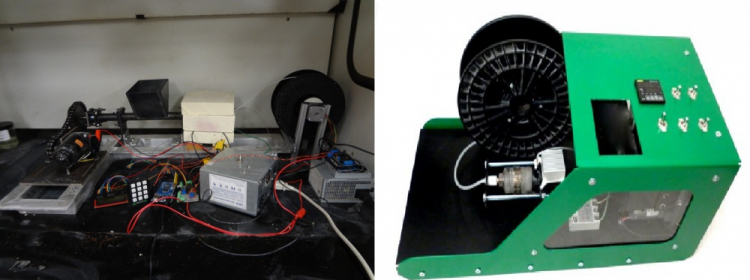Turning old plastic into 3D printer filament is greener than conventional recycling

3D printing technology empowers people to be both designer and manufacturer in their own home. But, let's be honest, it is so expensive. It uses plastic material for building objects, but each spool of plastic costs around $30.
But you can drive the cost down by making your own filament from empty shampoo bottles and milk jugs. A study led by Joshua Pearce of Michigan Technological University has shown that making your own plastic 3D printer filament from milk jugs uses less energy - often a lot less - than recycling milk jugs conventionally.
Household polymer waste, such as milk jugs, are a costly nuisance, either to recycle or to bury in a landfill. Pearce's team did a life-cycle analysis on a run-of-the-mill milk jug made from HDPE plastic. After cleaning it and cutting it in pieces, they ran it through an office shredder and a RecycleBot, which turns waste plastic into 3D printer filament.
Compared to an ideal urban recycling program, turning milk jugs into filament at home uses about 3 percent less energy, state the team. "Where it really shows substantial savings is in smaller towns like Houghton, where you have to transport the plastic to be collected, then again to be recycled, and a third time to be made into products," said Pearce, an associate professor of materials science and engineering/electrical and computer engineering. Then the energy savings skyrocket to 70-80 percent. And, recycling your own milk jugs uses 90 percent less energy than making virgin plastic from petroleum.
Pearce also compared the cost of making your own filament with buying it.
"Filament is retailing for between $36 and $50 a kilogram, and you can produce your own filament for 10 cents a kilogram if you use recycled plastic," he said. "There's a clear incentive, even if you factor in the cost of buying the RecycleBot."
Commercial variants like the Filastruder cost under $300.
But milk jugs are made of high-density polyethylene, or HDPE, which is not ideal for 3D printing. "It shrinks slightly as it cools, so you have to take that into account," said Pearce. "But if you are making something like a statue or a pencil holder, it doesn't matter."

This new recycling technology has caught the eye of the Ethical Filament Foundation, which works in partnership with organisations around the world to encourage the manufacture of ethically produced 3D printing filament, made from recycled plastic waste, as an alternative to the standard virgin plastic variety.
Another emerging organization, the Plastic Bank, is turning the problem of plastic waste and reshaping it into a solution. The Plastic Bank is a plastics return, repurposing, and 3D printing center that empowers the poor to harvest plastics as a currency for various opportunities including education, training, necessities and 3D printing services. Its mission is to remove plastic waste from the land, oceans and waterways while helping people ascend from poverty and transition into entrepreneurship.
"In the developing world, it's hard to get filament, and if these recyclers could make it and sell it for, say, $15 a kilogram, they'd make enough money to pull themselves out of poverty while doing the world a lot of good," he said.
The study, "Life-Cycle Analysis of Distributed Recycling of Post-consumer High Density Polyethylene for 3-D Printing Filament," by Megan Kreiger, Meredith Mulder, Alexandra Glover and Pearce, all of Michigan Tech, was published Feb. 12 in the Journal of Cleaner Production. An open access version is available from Academia.edu.







